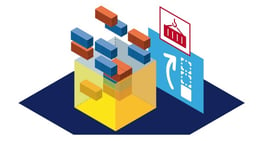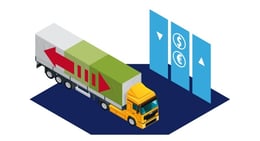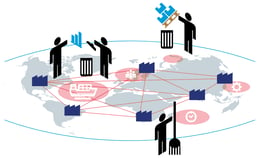Optimize Transport Logistics to Reduce Waste
Jesse Kelber - January 23, 2020
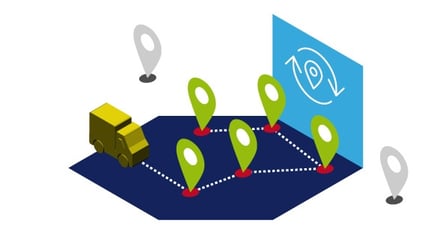
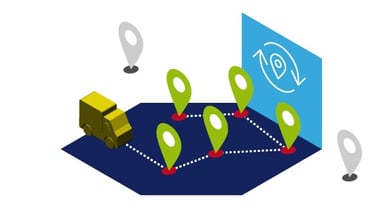 Ever had one of those days where you set out to run three easy errands but end up driving in multiple circles, making 7 unplanned stops and not getting home until well after dinner? Us too, and this is an apt analogy for how some supply chain transportation logistics networks are running these days—with trucks making multiple partial runs, unplanned stops being added to the itinerary at the last minute, and containers sitting on the dock for days. Transportation logistics is chock full of low hanging fruit when it comes to optimizing your network and reducing waste. With the unnecessary movement of goods, half-empty trucks, and trucks sitting around while warehouse staff scramble to find the entire order—this is an area ripe for optimization. We’re going to look at a handful of examples of how you can start working toward the goal of cutting transportation logistics waste from your supply chain.
Ever had one of those days where you set out to run three easy errands but end up driving in multiple circles, making 7 unplanned stops and not getting home until well after dinner? Us too, and this is an apt analogy for how some supply chain transportation logistics networks are running these days—with trucks making multiple partial runs, unplanned stops being added to the itinerary at the last minute, and containers sitting on the dock for days. Transportation logistics is chock full of low hanging fruit when it comes to optimizing your network and reducing waste. With the unnecessary movement of goods, half-empty trucks, and trucks sitting around while warehouse staff scramble to find the entire order—this is an area ripe for optimization. We’re going to look at a handful of examples of how you can start working toward the goal of cutting transportation logistics waste from your supply chain.
Look at Your Transportation Logistics from a New Perspective
A great way to start when optimizing your transport network is by stepping into your customers’ shoes to get a new perspective on your logistics network and where there’s waste to trim. Being on the inside, you’re accustomed to the view you get from your office chair. Try visiting a customer’s site and literally watching them place a new order, then track one in transit, and finally see one arrive at their door. This process will be a guaranteed eye-opener, as any time you can shift your perspective it can open up views on existing processes you may never have contemplated. For example, you may discover that the delivery delays they’ve been complaining about are actually due to road work across town. The future of logistics is customer-driven—just look at the explosion of direct-to-consumer production and next-day (or even same-day) shipping options for proof of this new direction. What you learn from sitting in your customer’s place for a while is that supply chains often look much different from the outside, and waste may be more visible from that perspective.
Build a Virtual Model of Your Supply Chain
Digital twins have been around in industrial settings for years now. They’re starting to crop up in new sectors and are beginning to make their impact felt in manufacturing as well. A digital twin is, in essence, a virtual model of your end-to-end supply chain (or any particular segment of it that you need to focus on). This model gives you several benefits when it comes to optimizing your transportation network. First, you can see the 10,000 ft view of the entire network in one place. This can make the bottlenecks and other areas of waste stand out. Second, you can model changes to the network that eliminate said waste without affecting the real-world network. Then, once you see the success you’re looking for in the model, the changes can be deployed to the real-world version with limited negative impact or downtime. Lastly, your now updated digital twin can be used to monitor the network in real-time to see that your optimization efforts are working.
Implement Existing Protocols to Work Logically
There are numerous rubrics, protocols, and other sets of instructions in the business world that can help you ensure that your efforts are well documented and can help ensure successful network optimization projects.
PDCA
Plan, Do, Check, Act is prevalent in industrial settings as a protocol for taking professionally designed plans and implementing them. These plans are often developed by outside contractors brought in for their expertise in one area of the business and following their plans to the letter can allow you to fine-tune your actions and continually monitor the impact each optimization has on the network as a whole.
OODA
Also known as the OODA Loop, this one stands for Observe, Orient, Decide, Act. Originating in a military setting, the OODA loop does not assume a plan is made ahead of time, rather it assumes that you’re working with what’s right in front of you in the moment. In that regard, it’s perfect for when the unexpected happens and you need to get your logistics moving again ASAP.
SMART
Specific, Measurable, Attainable, Relevant, Time-bound. That’s the SMART rubric as it’s used across business sectors to ensure that strategic goals are aligned with the outcomes the company is seeking. By ensuring your goals are actionable and concise, the project will proceed smoothly and you’re far more likely to see the outcomes you’re looking for.
Working logically by following established business best practices and protocols will not only help you locate the waste in your logistics chain but can provide a set of clear instructions for experimenting with possible solutions to help implement the best strategy for eliminating that waste. This works as well as it does because you can rest assured that every goal you outline will be actionable.
Tackle Your Network Holistically, or One Segment at a Time
Create a process map of your transportation logistics. This will give you that 10,000 ft view of the end-to-end network in action. All the moving parts need to be included so you can see clearly where the bottlenecks, inefficiencies, or disruptions are coming from. Process maps are created by analyzing your business processes, either manually or by using process mining software. Remember that logistics starts in the warehouse and goes all the way until the goods are delivered to the customer, so there are a lot of people and other moving parts to include. The other option here is to look at one segment of your network at a time. Isolate each step, starting with pick-and-pack and going all the way to last-mile delivery. By addressing each stage individually, you’re more likely to see the seemingly insignificant widget that’s causing a snowball effect and ultimately is responsible for late deliveries and other areas of waste spending. The key is to pick one level to address, then stick to it. If you start out to produce that overall logistics process map and get bogged down in loading dock procedures, you can lose sight of the broader goal.
For Ongoing Success, Establish KPIs and Reporting Channels
The last step of any successful optimization project is to establish the metrics, KPIs, and reporting channels needed to ensure ongoing monitoring. This may be a re-establishing process if you already had metrics in place. However, even if you didn’t it would behoove you to create a framework now so you can monitor results going forward. Once your changes are in place and you’ve eliminated the waste from your logistics processes, you need to know what metrics to watch to ensure that waste doesn’t creep back into the network. Documenting these numbers, who is responsible for them, and where they report their results so everybody stays up-to-date is all key to the long term success of your optimization project and keeping your transportation logistics network waste-free.
LATEST POSTS
- Understand Circular Economy in The Manufacturing Industry
- How Can Industry 4.0 IT Integration Be Achieved Smoothly?
- The Significance of Order Sequencing in Discrete Manufacturing
- How to improve your Supply Chain Management: The Power of Control Towers
- Optimizing Human Resource Scheduling in Manufacturing: A Technological Approach

